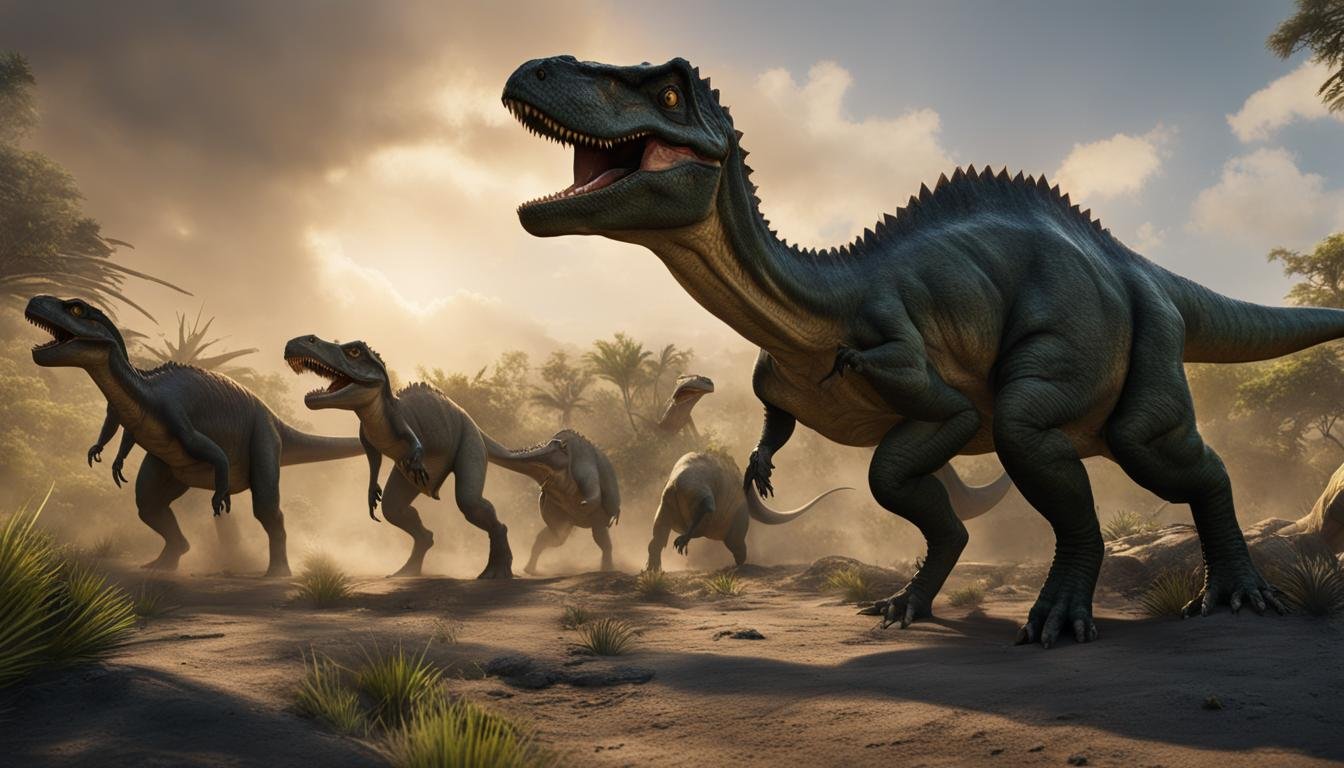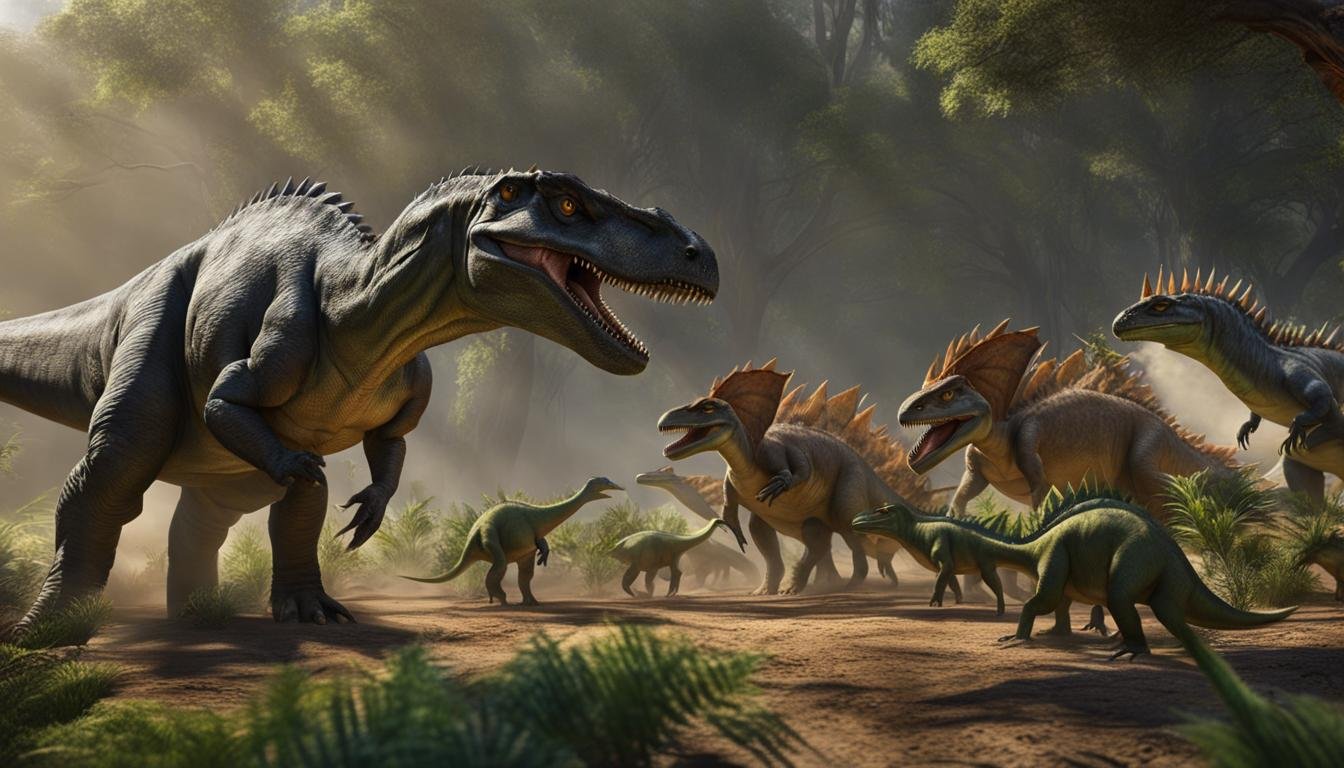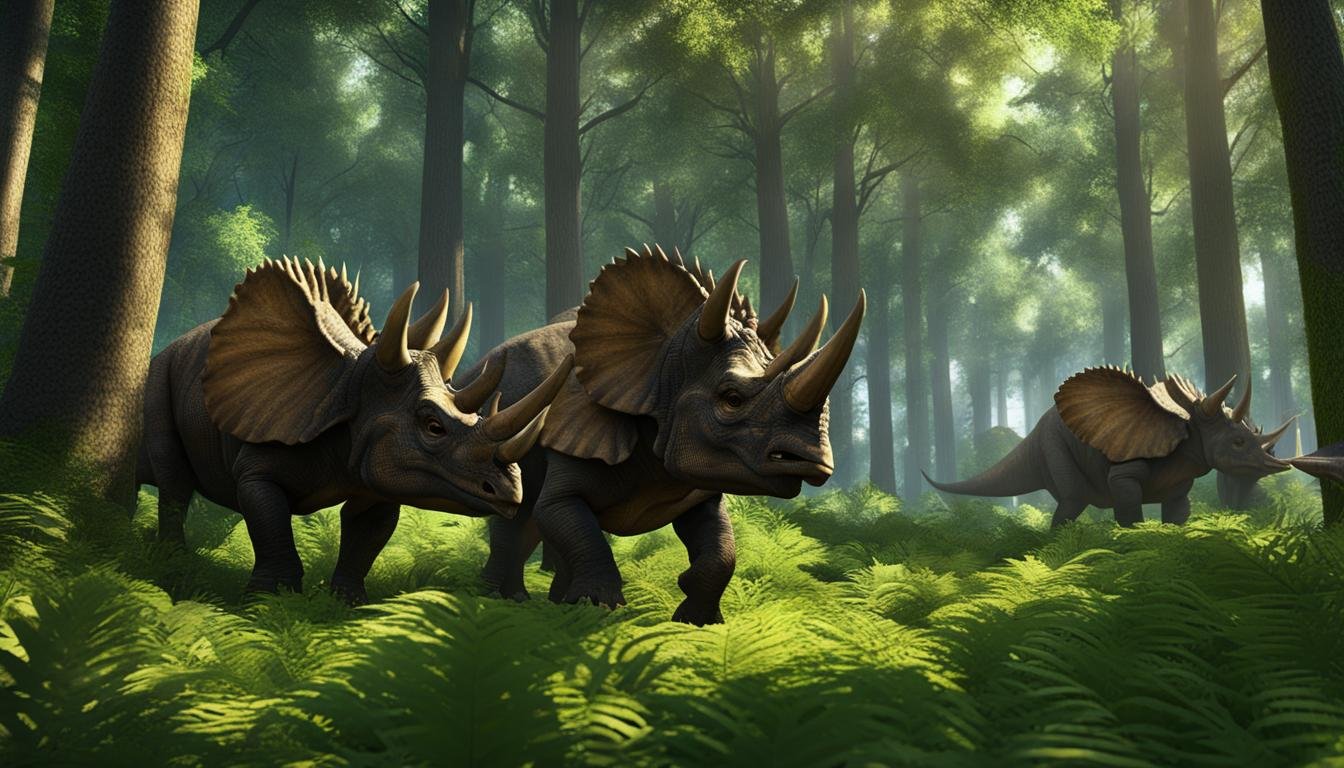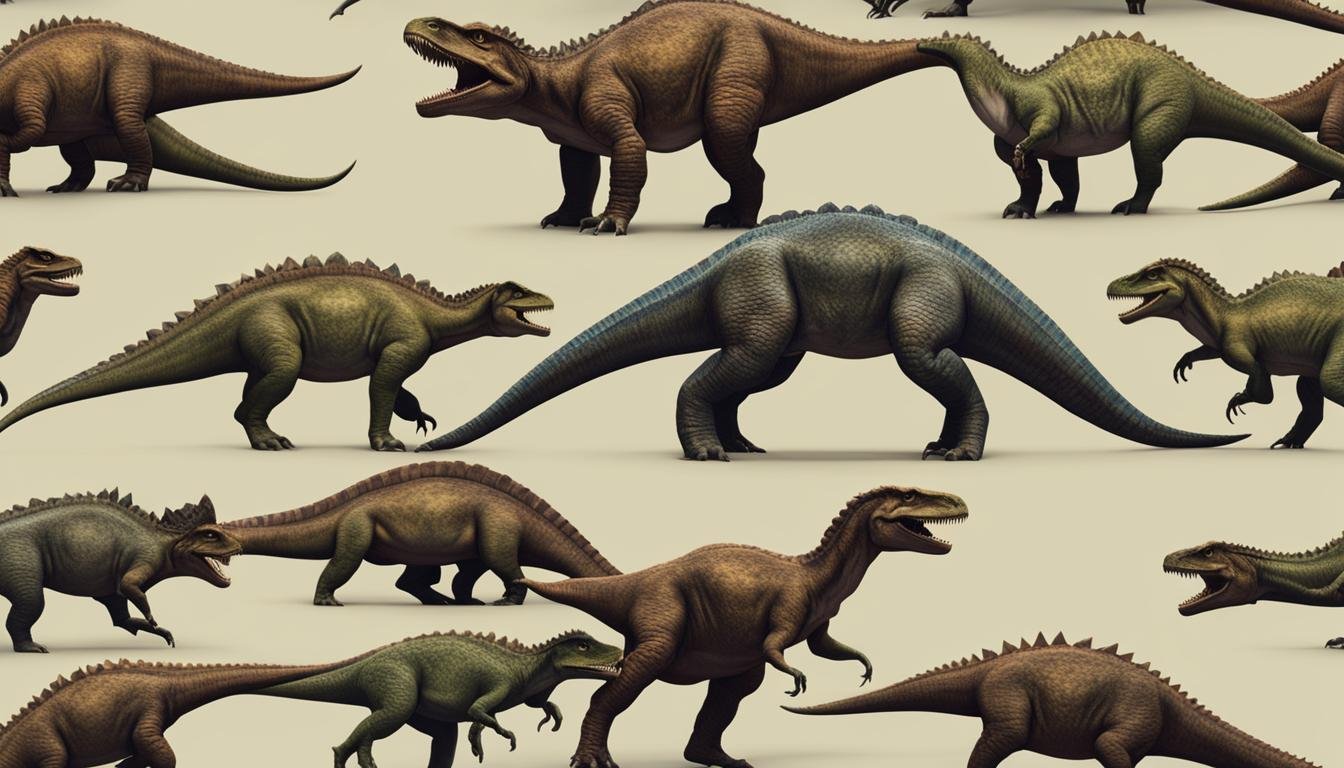Dinosaurs, the magnificent creatures that once roamed the Earth, possessed remarkable defense mechanisms and group protection strategies to safeguard themselves from predators. These adaptations allowed them to survive and thrive in a harsh prehistoric world. In this article, we will explore the fascinating ways dinosaurs defended themselves and coordinated their efforts for collective security.
| Key Takeaway | Detail |
|---|---|
| Evolution of Defense Mechanisms | Dinosaurs developed various defense mechanisms to survive in a dangerous prehistoric world. |
| Importance of Speed | Speed was a critical defense mechanism, enabling dinosaurs to escape predators. |
| Camouflage for Survival | Camouflage and the ability to blend in with the surroundings helped dinosaurs to stay hidden and safe from predators. |
| Physical Defense Weapons | Some dinosaurs evolved physical weapons like tail spikes and armored plates as a means to defend against attackers. |
| Group Protection Strategies | Dinosaurs adopted group protection strategies, such as traveling in herds and cooperative defense, to enhance their survival chances. |
Sprinting from Danger: Speed as a Defense Mechanism
When it came to defending themselves against predators, some dinosaurs relied on their incredible speed as a means of escape. One such dinosaur was the Gallimimus, which possessed long, thin legs that allowed it to take large strides and reach speeds of up to 35 mph. This impressive speed made it extremely difficult for larger predators, like the Tyrannosaurus, to catch them. By sprinting from danger, the Gallimimus effectively deterred potential predators and increased its chances of survival.
The ability to outrun predators provided an advantageous escape tactic for many dinosaurs. Speed allowed them to quickly put distance between themselves and their would-be attackers, reducing the likelihood of being caught. This defense mechanism was particularly useful for dinosaurs inhabiting open and flat areas, where their speed could be fully utilized.
It’s important to note that not all dinosaurs relied solely on speed as a defense mechanism. While some dinosaurs could reach impressive speeds, others relied on different tactics, such as camouflage or physical weapons, to protect themselves. Each dinosaur species had its own unique adaptation to survive in their environment, showcasing the diverse range of defense strategies that evolved over millions of years.
| Dinosaur | Top Speed (mph) |
|---|---|
| Gallimimus | 35 |
| Velociraptor | 40 |
| Dilophosaurus | 30 |
Camouflage and Blending In: Defensive Posturing
One of the key defense mechanisms employed by dinosaurs was blending in with their surroundings through camouflage. While the exact colorations of dinosaur skin remain a mystery, scientists believe that patterns and colors could have helped them hide from predators. By matching their environment, these dinosaurs would have been able to remain undetected, increasing their chances of survival.
In addition to camouflage, some dinosaurs may have utilized defensive posturing to avoid being spotted by predators. This defensive behavior could involve crouching down or freezing in place, allowing the dinosaur to blend in even more effectively. By remaining still and blending seamlessly into their surroundings, these dinosaurs were able to minimize the chances of attracting the attention of predators.
The effectiveness of camouflage and defensive posturing as defense strategies is supported by fossil evidence. Fossils of dinosaurs with coloration patterns similar to their environment have been discovered, suggesting that they were indeed capable of blending in. These adaptive strategies allowed dinosaurs to stay hidden from potential threats and survive in their prehistoric world.
Examples of Camouflage and Defensive Posturing
| Dinosaur | Camouflage Adaptations | Defensive Posturing Behaviors |
|---|---|---|
| Velociraptor | Feathers with coloration matching their environment | Freezing in place to avoid being detected |
| Camarasaurus | Mottled skin to blend in with trees and foliage | Crouching down to hide behind vegetation |
| Proceratosaurus | Striped pattern to break up their silhouette | Remain motionless to blend in with tall grasses |
These examples highlight the variety of camouflage adaptations and defensive posturing behaviors employed by dinosaurs. Each dinosaur had unique ways of blending in with their surroundings, demonstrating the effectiveness of these defense strategies in helping them evade predators and increase their chances of survival.
Weapons and Armor: Tail Spikes and Armored Jackets
When it came to defending themselves against predators, dinosaurs didn’t just rely on their speed and camouflage. Some dinosaurs evolved physical weapons and armor to fend off attackers. Let’s explore two fascinating examples: tail spikes and armored jackets.
Tail Spikes
One of the most iconic defensive adaptations of certain dinosaurs was their formidable tail spikes. Ankylosaurs, such as Ankylosaurus and Euoplocephalus, possessed club-like tails with large, bony spikes at the end. These tail spikes were formidable weapons that could inflict serious damage on any predator foolish enough to approach. Imagine the force behind those bone-crushing strikes!
These tail spikes were not just for show. Fossil evidence suggests that ankylosaurs likely used them defensively, swinging their tails to repel attackers. They may have even had the ability to aim these spikes accurately, making them a formidable deterrent. These armored giants had a unique combination of offensive and defensive capabilities, making them a force to be reckoned with in the dinosaur kingdom.
Armored Jackets
Another fascinating aspect of dinosaur defense is the presence of armor plating. Stegosaurus, for instance, possessed a series of bony plates running along its back. These plates acted as a shield, providing protection from potential predators. Imagine the sight of a fully armored Stegosaurus, ready to defend itself!
But the armor plating didn’t stop there. Stegosaurus also had pairs of large, pointed spikes at the end of its tail. These tail spikes posed a significant threat to any predator attempting to attack from behind. With a well-placed swing of its tail, Stegosaurus could send a clear signal that it was armed and not to be messed with.
The evolution of tail spikes and armor plating in dinosaurs showcases the incredible adaptations that allowed these creatures to survive in a dangerous and ever-changing world. From powerful swings of spiked tails to the impenetrable defense of armored jackets, these defense mechanisms played a crucial role in the lives of dinosaurs.
Now, let’s summarize the key points discussed in this section:
- Ankylosaurs had club-like tails with tail spikes that they used defensively.
- Stegosaurus possessed armor plating along its back and tail spikes as a double defense mechanism.
- Tail spikes and armor plating were effective deterrents against predators.
- These defensive adaptations showcased the survival strategies of dinosaurs.
Understanding Group Protection in Dinosaurs
In the prehistoric world, survival often depended on strength in numbers. Dinosaurs, like many creatures, developed group protection strategies to enhance their chances of survival. This section explores how these magnificent creatures used collective behavior for defense.
| Strategy | Description | Examples |
|---|---|---|
| Traveling in Herds | Moving in large groups for safety and increased vigilance | Triceratops, Hadrosaurs |
| Cooperative Defense | Forming protective formations during attacks | Stegosaurus, Ankylosaurs |
| Vocal Communication | Using sounds to alert the herd of danger | Parasaurolophus, possibly hadrosaurs |
| Sentinel Behavior | Assigning lookouts while others rest or feed | Smaller ornithopods, sauropods |
Traveling in Herds: Safety in Numbers
Many herbivorous dinosaurs, such as Triceratops and Hadrosaurs, traveled in large herds. This strategy was not just for socialization; it provided a layer of protection. With more eyes to spot danger, these herds could effectively warn each other of approaching predators. Also, the sheer size of a herd could be intimidating, deterring potential attackers.
Cooperative Defense Behaviors
In some cases, dinosaurs demonstrated cooperative defense behaviors. For instance, when under threat, the members of a herd could form protective circles, with the young and vulnerable in the center and the adults facing outward, ready to fend off attackers. This formation was particularly effective against predators who relied on isolating a single target.
Vocal Communication and Alarm Calls
Evidence suggests that dinosaurs, like many modern animals, may have used vocalizations for communication. In a group setting, these calls could serve as alarm signals, alerting others in the herd to danger. Quick communication was crucial for group protection, allowing the herd to respond collectively to threats.
Sentinel Behavior and Lookouts
Some dinosaurs may have exhibited sentinel behavior, where one or more individuals stood watch while others fed or rested. This lookout system ensured that at least one member of the group was always monitoring for predators, providing an early warning system for the herd.
Nesting Colonies for Collective Safety
Nesting in colonies was another strategy used by some dinosaur species. By grouping their nests together, parents could more effectively protect their eggs and young from predators. There was safety in numbers, even at the earliest stages of life.
Conclusion
In conclusion, dinosaurs employed a combination of individual defense mechanisms and group protection strategies to enhance their chances of survival in a prehistoric world full of predators. These survival strategies played a crucial role in their ability to thrive and adapt to their environment.
Group protection strategies were particularly important for herbivorous dinosaurs. Many of them traveled in herds or packs, allowing for safety in numbers. This cooperative defense behavior provided multiple pairs of eyes to keep a lookout for predators and increased their collective ability to deter or evade threats.
Within these groups, dinosaurs exhibited various cooperative defense behaviors. They communicated through alarm signals to alert others to potential dangers, engaged in group surveillance to identify and track predators, and employed defensive herding techniques to protect each other from attacks.
By utilizing these group protection strategies alongside their individual defense mechanisms such as speed, camouflage, and physical weapons like tail spikes and armor plating, dinosaurs were able to navigate the challenges of their ancient world and increase their chances of survival. Their ability to work together as a cohesive unit and adapt to changing environments was key to their success and continued existence.









